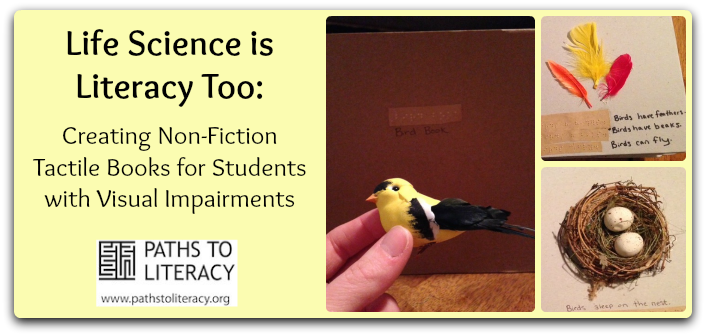Life Science is Literacy Too: Creating Non-Fiction Tactile Books for Students with Visual Impairments
I wanted to create some "science" books for my son Liam (he just turned 6 years old and is deafblind) for him to use for the next school year. I looked up first grade standards and noticed a focus on animals and their habitats, life cycles, needs, etc. I thought why not make some non-fiction books for him?!
I wanted to focus on creating books on animals that would interest him. I also wanted to choose an animal to highlight in a book that he could experience and feel in "real-life" (at a petting farm, zoo, in nature, etc.). I started brainstorming a list of animals (reptiles, insects, etc.) and came up with the following:
-
Bears (We have a place called "Bear Country" in our hometown where he could touch a baby cub.)
-
Turtles (We have a place we visit often called "Reptile Gardens" where Liam can touch huge tortoises and turtles.)
-
Goats and Cows (We often visit the local petting farm and the baby goats and cows are his favorite!)
-
Birds (I was thinking the baby chicks at the local petting farm and then finding a family friend who has a bird in their home that Liam could touch.)
Those were just a few examples of animals that I want to focus on. I hope to plan "experiences" for Liam to go actually touch these animals and then get to learn more about them through a non-fiction book made about that specific animal (at his level!!!).
The first book I have made in Liam's "Non-Fiction" collection is:
"Bird Book"
I choose 2-3 simple sentences per page, with tactile graphics as close to "real-life" as I could to match the sentences. I also choose to address (simplified!) the life cycle, features, and basic needs of a bird.
I also added, on the left side of each "page" a single vocabulary word that can be used as a focus point for vocabulary and braille word identification.
Extensions:
- Your non-fiction books could add non-fiction conventions (like the books of their peers!) such as an index, diagrams, glossary, captions, etc.
- You could have a box full of items about the animal they are learning about.
- Perkins has a program of taxidermy animals that you can borrow. Click here to learn more.
- Plan to go visit the animal that is being highlighted in your book.
- Your child could create a tactile picture of the animal.
- Do a science lesson. For example: Birds fly. Flying can be a hard concept to grasp for a child who is blind or deafblind to understand. It would be great to spend more time on certain concepts mentioned in the book.
Variations:
These books are great for meeting the unique needs of your child! You can choose to have more or fewer words. You can choose to focus on one feature or topic only about the animal or you can add more!
See also: Tactile Books about the Life Cycle of Turtles and Frogs


Comments
Dogs and Cats
Animal Boxes
Great ideas!